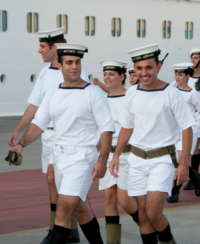Uniforms of the Navy Royal (Great Nortend): Difference between revisions
| Line 8: | Line 8: | ||
Junior ratings do not receive mess dress, who wear No. I full dress instead. | Junior ratings do not receive mess dress, who wear No. I full dress instead. | ||
==No. III undress== | ==No. III undress== | ||
For officers, undress consists of a more practical form of the full dress tailcoat in the form of a tunic. | For officers, undress consists of a more practical form of the full dress tailcoat in the form of a navy tunic with standing collar. It is worn with ordinary dress trousers. The dress epaulettes are also replaced with gold shoulder boards. Headdress is the peaked cap. | ||
For junior ratings, undress derives from the historical working dress of sailors. It consists of a square-collar white flannel shirt with navy stripes, a navy sailor frock with collar and neckerchief, white waist belt, bell-bottomed trousers and ankle boots. | For junior ratings, undress derives from the historical working dress of sailors. It consists of a square-collar white flannel shirt with navy stripes, a navy sailor frock with collar and neckerchief, white waist belt, bell-bottomed trousers and ankle boots. | ||
Revision as of 04:38, 27 September 2020
The uniforms of the Navy Royal of Great Nortend are worn by seamen and officers in the exercise of their duties. There are five main orders of dress.
No. I full dress
For officers, full dress consists of the dress blue tailcoat.
For junior ratings, full dress is the traditional Erbonian sailor suit. This consists of a square-collar white flannel shirt with navy stripes, a navy parade coat with collar and neckerchief, dress trousers, white gaiters and ankle boots.
No. II mess dress
Junior ratings do not receive mess dress, who wear No. I full dress instead.
No. III undress
For officers, undress consists of a more practical form of the full dress tailcoat in the form of a navy tunic with standing collar. It is worn with ordinary dress trousers. The dress epaulettes are also replaced with gold shoulder boards. Headdress is the peaked cap.
For junior ratings, undress derives from the historical working dress of sailors. It consists of a square-collar white flannel shirt with navy stripes, a navy sailor frock with collar and neckerchief, white waist belt, bell-bottomed trousers and ankle boots.
No. IV deck dress
For officers, deck dress consists of an open-collared double-breasted navy reefer jacket with pockets. A white shirt with detachable collars is worn underneath with a black silk neck tie. Navy trousers are worn with ankle boots.
For junior ratings, deck dress consists of a square-collar white flannel shirt edged in navy, sailor's collar and neckerchief, a navy tunic, a black waist belt, navy trousers, and ankle boots. In hot climates No IVB may be worn with the tunic may be removed only or with white short trousers and navy stockings as well in lieu of trousers. The headdress is the sailor's cap or sennit hat.
Senior ratings wear a uniform similar to that of officers. However, their reefer jacket has only six buttons.
Deck dress is the ordinary dress of officers and seamen day to day.
No. V working dress
Working dress is generally worn as a durable rig when working in heavy duties when deck dress would be impractical. For junior ratings, working dress consists of the square-collar white flannel shirt edged in navy, a grey-blue working coat, black waist belt, navy trousers, black gaiters and ankle boots. The headdress is the sailor's cap or sennit hat.
A pullover may be worn underneath the working coat in cold weather. In hot weather, the coat may be removed and/or short trousers and stockings worn.
See also
References
This page is written in Erbonian English, which has its own spelling conventions (colour, travelled, centre, realise, instal, sobre, shew, artefact), and some terms that are used in it may be different or absent from other varieties of English. |



